One of our spring projects was to give a gift to pollinators and a boost to the ecosystem by building an insect hotel. This type of project is becoming increasingly popular, and it was our turn to make one, by gosh.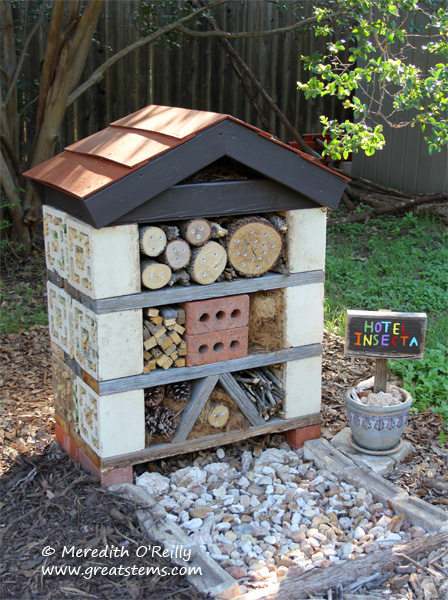
An insect hotel is a structure that offers native bees a place to build nests, a place for fireflies to lay their eggs, a place for lady beetles and butterflies and lacewings to seek shelter, and so on.
Part of the fun is building it with natural and re-used (untreated) materials, so making one can be super cheap. Ours cost us the price of one 2′ x 4′ piece of plywood, just a few bucks (we could have brought that price down to zero if we had called friends for a spare scrap, but rain was coming and we had to speed up a couple of steps).
Insect hotels can be done very simply, just by stacking materials such as old boards, pallets, or bricks. This makes it possible for even young kids to help create a hotel (check out this link for a huge variety of other people’s insect hotels). An adult should make sure the structure is safe and secure, but kids can help fill the open spaces.
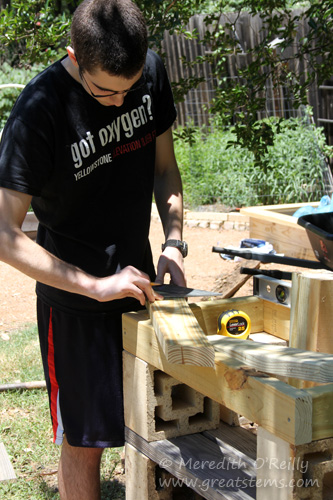
But older kids and adults can really go to town to build the insect hotel of their dreams, so to speak. It can become a real-life math problem, a science project, and an engineering or art or architecture project all in one. Ours is somewhere in between simple and fancy. It LOOKS fancy, but it was remarkably simple — best of both worlds! So while there are lots of ways to build insect hotels, I’m just going to show you how we did ours.
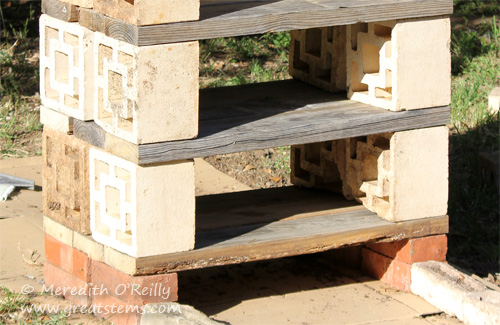
You start with what you have at home or can get for free — this makes every insect hotel unique (what a wonderful concept!). We had five things at home that made this project straightforward and easy to do. The first is that we had 12 vintage screen blocks our neighbor passed along to us a few years ago — we kept them until we could figure out a perfect project for them. We also had an assortment of bricks, decaying wood from one of our raised vegetable beds that was in need of repair, scrap pieces of 2×4 in the garage (for the roof), and lots of natural materials from our garden and yard (sticks, leaves, etc.).
The vintage blocks set the stage for the design, as they also set the height of the shelves. We spaced them just far enough to allow for potential partitions (we would use more decaying wood and some bricks to create these). To add just a bit of additional height, we used two layers of bricks as the base, then cut the veggie-bed wood to size to create the shelves. The reason for the height from the bricks was to be able to add leaf litter underneath the insect hotel to give toads a place to find shelter, caterpillars a place to overwinter, and lizards a place to lay eggs. I should probably mention that we also removed grass and laid down cardboard as a barrier to weeds (the cardboard will break down quickly but will block out light nicely for a while to keep weeds at bay).
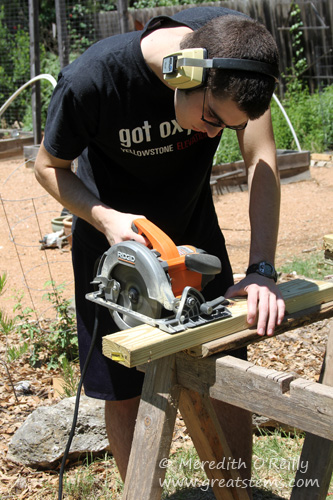 The roof was the only part where we used new wood, that 2×4 plywood I mentioned, plus some scrap wood lengths we had in the garage.
The roof was the only part where we used new wood, that 2×4 plywood I mentioned, plus some scrap wood lengths we had in the garage.
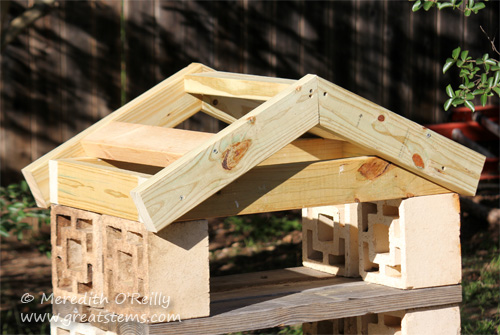
You can see the basic roof design my kids and husband created to fit the hotel. This is the only piece that involved nails of any sort — everything else is stacked only.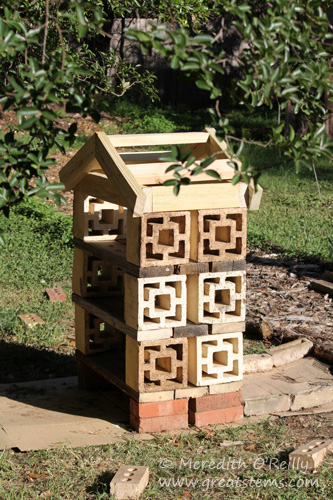
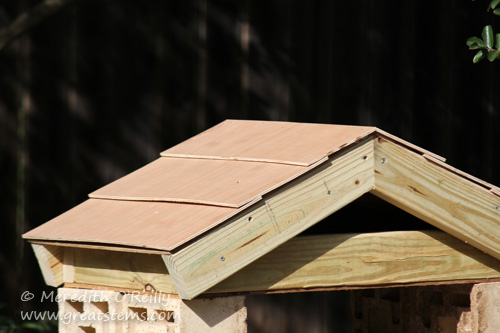
The plywood was used to make shingles of a sort. A bit of caulk at the top filled the seam.
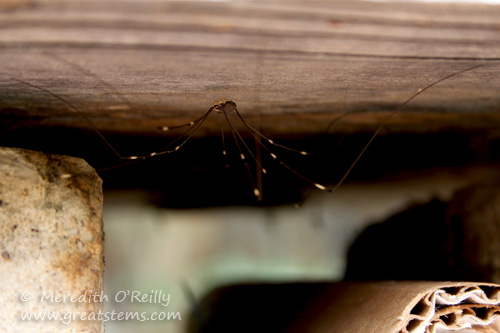
Already at this point, a harvestman and a tiny orbweaver spider had moved in. Clearly they were eager for bug feasts to come.
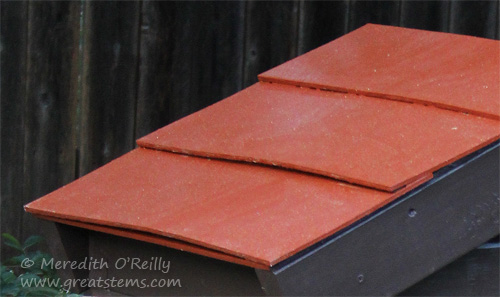 I painted the top section using leftover paint from our house’s exterior — this makes the insect hotel fit the setting nicely, as it matches our house and the color scheme of our garden’s decorations. Of course, it rained that very night, so in the picture it looks dirty. Rain came again for a few days after that — I was so glad the roof was done.
I painted the top section using leftover paint from our house’s exterior — this makes the insect hotel fit the setting nicely, as it matches our house and the color scheme of our garden’s decorations. Of course, it rained that very night, so in the picture it looks dirty. Rain came again for a few days after that — I was so glad the roof was done.
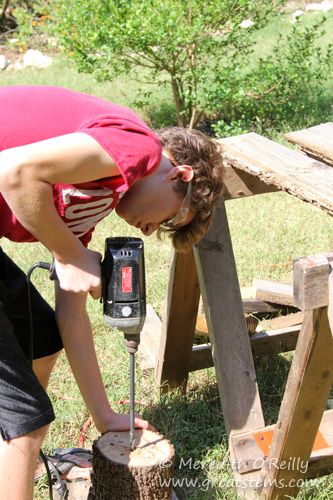
For filling the spaces, our priority was to create places for native bees to build their nests. We collected logs from the yard for this, using a chainsaw to cut them to an appropriate length. Following mason bee nest box instructions, we drilled holes 6″ deep into the wood (the deeper holes allow for female bee eggs — shallower ones produce male bees). So that we could add homemade paper liners to better protect the bees (again, following the advice of experienced mason bee keepers), we used a 3/8″ drill bit rather than the traditional 5/16.”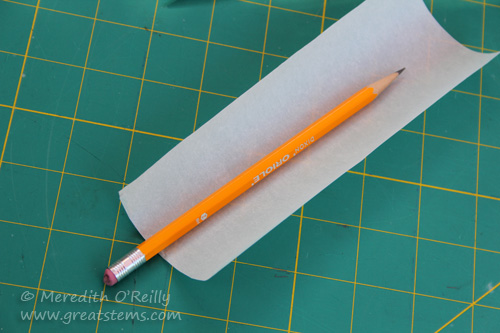
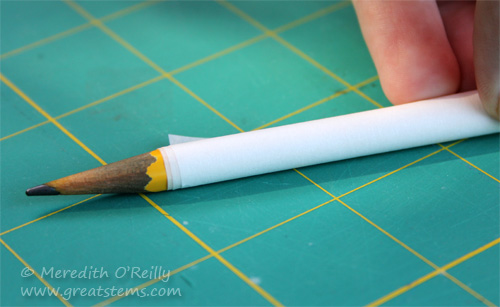
To make liners for the tubes, we cut parchment paper to about 3″ x 6″. These we rolled tightly with a pencil, then inserted them into the holes (they unrolled nicely inside to make a good liner). The liners bring the hole diameter to about the 5/16″ preferred by mason bees.
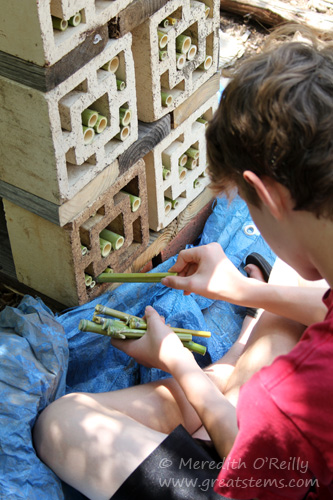
The screen block was a perfect place to add additional places for nesting bees and other critters. A neighbor on our street is always happy for us to cut down the running bamboo that is invading her yard from her nearby neighbor’s property, so we gathered bamboo, trimmed off the branches, and sliced the bamboo into 6″ lengths of all diameters to fill the holes.
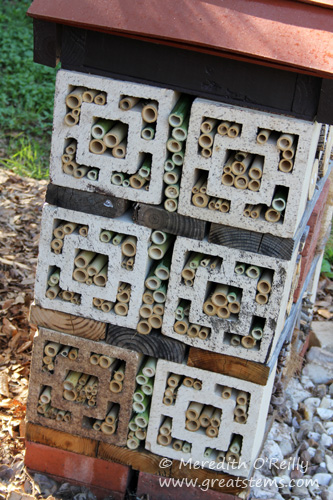
Here we were casual about it — there are lots of different sizes for many species of insects interested in using the bamboo. Some were cut with the bamboo joint at one end, so they are open only from the opposite end (nice for shelter or nesting), while others are open at both ends, allowing an insect to pass into the main hotel structure if it desires.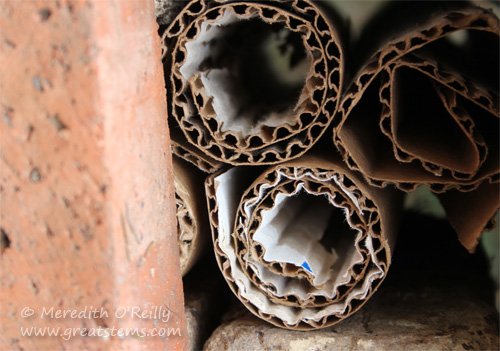
On the middle shelf of the insect hotel, we created partitions with bricks, then inserted rolled corrugated cardboard as lacewing shelters. 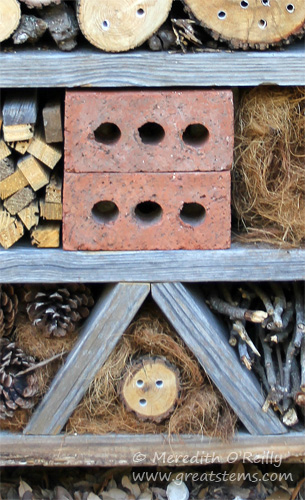
Additional bricks, with the holes open from the front, protect the cardboard and insects while allowing easy passage for the critters to enter and exit. We also made “A”-shaped partitions simply by cutting more veggie-bed wood to size and sliding it in — no nails required.
Other materials used were decaying wood slices for firefly larvae, loosely placed coir fiber as a general shelter place for small insects, and twigs and pine cones and other wood bits for additional shelter. We filled the roof section with pine straw needles. Though we intended it for insects, it wouldn’t surprise me if Carolina Wrens or other birds will nest in the roof’s pine straw one day. They might think an insect hotel is a perfect place to build their home — convenient food on the spot!
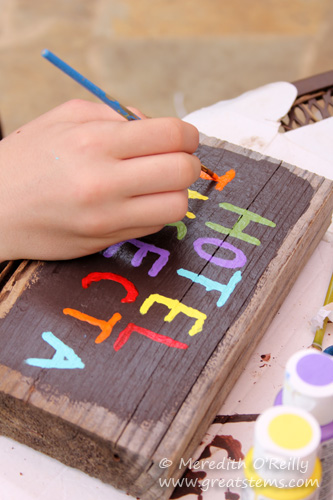
Of course, there was one more finishing touch needed. A grand-opening sign! We made use of some more rotting wood from the old veggie bed and some more outdoor paint, including outdoor acrylic, that we had on hand. We attached a supporting piece of wood to the back, then stuck the sign into a plant pot with some rocks (see top photos above).
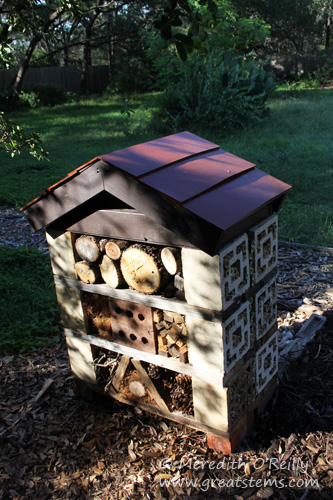
View from the back
The back of the insect hotel duplicates the front half, mainly because we liked the front so much.
We’re already seeing evidence of bees building nests, and other critters (including more little spiders) have moved in. What a simple but rewarding project! Though we could have finished this in just a day or two, we spread it out over time due to occasional rainstorms. The most time-consuming part, honestly, was drilling the holes in the logs. You have to take a lot of breaks to let the drill and drill bit cool down — they get hot!
To see a couple of other nifty Austin insect hotels, visit Sheryl’s tall, well-planned structure at Yard Fanatic and Vicki’s clever use of an antique bottle rack to make her uniquely awesome Bee B&B at Playin’ Outside. Another gorgeous insect hotel is Gail’s pollinator condo at Clay and Limestone in Tennessee. Remember to also check out the link at the top to get even more ideas!
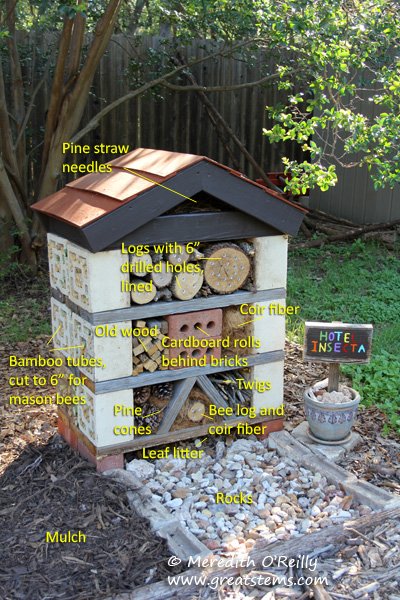
What a great project, and it looks fantastic! If I build one of these I’m going to have to tie things together somehow, or “somebody” will probably bump into it and knock it over. 🙂
Thanks for adding all of the important details too!
The weight of the blocks combined with the solid roof structure makes this remarkably sturdy. Some people use pallets, which are nice and big to start with. I think it would be a challenge to accidentally knock one of these over, Alan! But of course, it all starts with your basic plan and available materials.
Always mean to mention that your “security math” is a good refresher. Loved the detailed “how-to” you gave in this post, and truly admire the finished product.
Ah, the CAPTCHA thing — it took me a while to figure out what “security math” had to do with insect hotels! Thanks, Vicki. I just got your link — I’m adding it in now!
Very nice! We have been looking at different designs for our garden. I appreciate your how to steps! I am curious how you decided on the location…sunny, part shade, shade…what is best?
Hi, Karin — sorry for the delay in responding — it’s been busy for me here the past couple of weeks. In answer to your question, because we live in Texas and our backyard gets crazy hot, we chose a spot that lets the front side of the hotel get sun, while the back is under the shade of the tree behind/above it. That way the insects can choose sun or shelter for their nests. Some bee sites say to put bee boxes in a sunny spot in the garden, but I don’t think they are thinking of Texas’ Death Star-like sun and heat — in fact, our other bee boxes under the trees have seen plenty of visitors.
Wonderful detail and pictures! My DH was studying this blog with great interest. I think an insect hotel will be coming to my garden real soon.
I look forward to pictures, Ally! It really is a fun project. We’re already seeing lots of insects.
Meredith, That is a beautiful condo! Thank you for mentioning mine…I am now going to get the coir fiber to add to the garden. Thank you for the kind link!
Gail, I love your pollinator condo, too. And the coir fiber was salvaged from some hanging pots that no longer held soil well. I was glad to be able to repurpose the fiber!
Pingback: Wildlife Project: Bee Boxes | Great Stems
Pingback: How Do I Teach Nature Study? Day 1: Finding & Attracting Nature | Are We There Yet?
Pingback: Hotel za kukce - Urbana vrtlarka
Pingback: Winter Ahead
Love the look! I live in Coastal NC, and we have to be careful of cardboard outside because it draws termites. Is that an issue for this Hotel Insecta? I love the idea and hope it would draw the carpenter bees away from my deck!
Termites exist naturally around us, but I don’t worry about them too much, as we have a stone house. The insect hotel is many yards from the house, however — I would say that if you have concerns, keep it away from your house and fence line. I haven’t seen cardboard bring an increase in termites (it tends to break down fairly quickly)– generally I find them mostly in old wood itself.
Pingback: Rescuing Bees | Great Stems
Pingback: Pondering Permaculture - The Homestead Garden | The Homestead Garden
Great website. My son will be using this as part of his Eagle Project
Wonderful, Tim — how did your son’s project turn out?
Pingback: New blue tuteur doubles as bee B&B | Digging